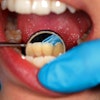
SAN FRANCISCO - Always informative, always entertaining, always outrageous -- that's Dr. Gordon Christensen, D.D.S., Ph.D. Pundit, prognosticator, and pugnacious critic, Dr. Christensen shared his skeptical views on the state of dentistry in his aptly named "New Aspects of Dentistry 2007" session yesterday at the ADA's 148th annual meeting.
The good news, according to Dr. Christensen? There's never been a better time to be a dentist. Fees are up (8% this year), esthetic and cosmetic dentistry continues to boom ("Half your income will come from this area" Dr. Christensen said, much of it from "mature" adults who can afford pricey procedures), the number of dentists remains steady while population grows (which means more patients per DDS), CAD/CAM systems for fabricating ceramic dental restorations in your office may be ready for prime time, and oh yes -- more and more women are becoming dentists.
The not-so-good news? There's still lousy dentistry going on out there, a lot of dentists are way behind the times technologically, labs aren't calibrating their furnaces (which means the crowns they fabricate may be porous), and dentists are still doing too many crowns, in Dr. Christensen's opinion.
Although he cracked un-PC jokes, dissed peer-reviewed journals, and constantly grilled the audience on clinical and chemical matters (often catching them flat-footed), Dr. Christensen delivered a cogent big picture of what's happening in the dental world.
Some of the highlights:
- CAD/CAM systems for modeling and creating crowns, onlays, and veneers are here- - notably the Cerec 3 -- if you're ready for them. "This is the tool of the future" said Dr. Christensen. "And dentists will come to love it -- if they take the time to learn it." Just remember, warned Dr. Christensen, that a system like the Cerec 3 costs about $2000 per month. "You'll have to do at least 20 units per month to pay for the machine.... Everything after that will be gravy." Dr. Christensen's view, in sum: "It's a wonderful system, and in the hands of a skilled dentist, I've seen some beautiful results -- better than many labs, and with similar longevity."
A show of hands in the audience revealed that half the attendees wanted to get into CAD/CAM ... and that maybe 5% actually had a system in their offices.
Bottom line advantages of CAD/CAM according to Christensen: potentially faster, less human involvement, more consistent and predictable results, and potentially, less expensive.
- Dentists are doing too many crowns, according to Dr. Christensen. "We should be doing more conservative restorations, notably, "onlays" -- what Christensen jokingly referred to as "three-quarter crowns." "They're better for the teeth, when the gum recedes the colors will match better, and they last forever. I've seen overlays last 20, 30 years," he said.
- Although they comprise 60% of the market, PFM crowns are on the way out. The trend is toward ceramic crowns. One big reason why: better soft tissue reaction. Lava, Cercon, e.max, and Everest will soon capture the market in Dr. Christensen's view.
- Remineralizing tooth structure. As Dr. Christensen explored the topic, many heads in the audience were nodding assent. Likely indications: postbleaching sensitivity, high caries activity, xerostomia, pregnancy, erosion, and so on. Using 5000 ppm fluoride products is a proven approach, said Dr. Christensen. Ditto, fluoride varnishes.
Another part of the solution: applying MI paste (amorphous calcium phosphate), which looks promising, but isn't proven. "The early research was shaky" noted Dr. Christensen. "We need more clinical observation, but I'm feeling good about these products overall." And there are lots of them, from Enamel Pro to GCAmerica's MI Paste. Dr. Christensen seemed to favor GCAmerica's products (based on research findings), and prefers using a tray instead of patients simply rubbing it on their teeth.
- Bleaching is still in high demand, with at-home bleaching booming. Small wonder, said Dr. Christensen, noting that surveys show 61% of patients are "very satisfied" with bleaching. "I was ecstatic when bleaching went home," Dr. Christensen said, since doing it in-office can be a mess. And by all accounts, the research indicates bleaching is safe.
Dr. Christensen's tips?
- 10 to 20% solutions produce the desirable bleaching effect. Anything stronger and you're risking greater sensitivity.
- Thicker trays are best -- in the realm of 0.040 inches
- Reservoirs aren't necessary.
- A 30-minute treatment is plenty -- after that, most of the active agent is gone.
- Office bleaching is effective, but the results are only good for about a year. At-home bleaching has greater longevity.
- 61% of dentists use lights to increase bleach effectiveness. "I don't know why," Dr. Christensen said. "They're useless! But everyone does it, so...."
His suggested at-home techniques?
- Scale and polish teeth.
- Wait a few days before bleaching.
- Bleach for half an hour to an hour.
- Change the gel in the tray.
- Continue bleaching for about a week.
- If the gel lacks desensitizing ingredients, clean the trays and put a desensitizing gel in the tray for five minutes.
Don't go overboard, Dr. Christensen said. "I've seen old ladies with dyed, jet-black hair and bleached, toilet-bowl white teeth. It looks like Halloween!"



















